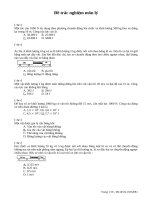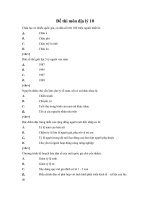- Trang chủ >>
- Đề thi >>
- Đề thi tuyển dụng
Đề thi trắc nghiệm môn C sharp (4)
Bạn đang xem bản rút gọn của tài liệu. Xem và tải ngay bản đầy đủ của tài liệu tại đây (668.79 KB, 10 trang )
Câu hỏi trắc nghiệm C# bằng tiếng anh có đáp án
31
A.
1, 3
B.
2, 4
C.
3, 5
D.
4 only
13. Which of the following statements is correct about the C#.NET code snippet given
below?
interface IMyInterface
{
void fun1();
void fun2();
}
class MyClass: IMyInterface
{
private int i;
void IMyInterface.fun1()
{
// Some code
}
}
A.
Class MyClass is an abstract class.
B.
Class MyClass cannot contain instance data.
C.
Class MyClass fully implements the interface IMyInterface.
D.
Interface IMyInterface should be inherited from the Object class.
E.
The compiler will report an error since the interface IMyInterface is only partially
implemented.
14. Which of the following statements is correct about the C#.NET code snippet given
below?
interface IPerson
{
String FirstName
{
get;
Câu hỏi trắc nghiệm C# bằng tiếng anh có đáp án
32
set;
}
String LastName
{
get;
set;
}
void Print();
void Stock();
int Fun();
}
A.
Properties cannot be declared inside an interface.
B.
This is a perfectly workable interface.
C.
The properties in the interface must have a body.
D.
Subroutine in the interface must have a body.
E.
Functions cannot be declared inside an interface.
15. Which of the following is the correct way to implement the interface given below?
interface IPerson
{
String FirstName
{
get;
set;
}
}
A.
class Employee : IPerson
{
private String str;
public String FirstName
{
get
{
return str;
}
set
{
str = value;
}
}
Câu hỏi trắc nghiệm C# bằng tiếng anh có đáp án
33
}
B.
class Employee
{
private String str;
public String IPerson.FirstName
{
get
{
return str;
}
set
{
str = value;
}
}
}
C.
class Employee : implements IPerson
{
private String str;
public String FirstName
{
get
{
return str;
}
set
{
str = value;
}
}
}
D.
None of the above
Câu hỏi Operators
1. Which of the following are the correct ways to increment the value of variable a by 1?
1. ++a++;
2. a += 1;
3. a ++ 1;
4. a = a +1;
Câu hỏi trắc nghiệm C# bằng tiếng anh có đáp án
34
5. a = +1;
A.
1, 3
B.
2, 4
C.
3, 5
D.
4, 5
E.
None of these
2. What will be the output of the C#.NET code snippet given below?
byte b1 = 0xF7;
byte b2 = 0xAB;
byte temp;
temp = (byte)(b1 & b2);
Console.Write (temp + " ");
temp = (byte)(b1^b2);
Console.WriteLine(temp);
A.
163 92
B.
92 163
C.
192 63
D.
0 1
3.
Which of the following is NOT an Arithmetic operator in C#.NET?
A.
**
B.
+
C.
/
D.
%
E.
*
4, Which of the following are NOT Relational operators in C#.NET?
1. >=
2. !=
3. Not
4. <=
5. <>=
A.
1, 3
B.
2, 4
Câu hỏi trắc nghiệm C# bằng tiếng anh có đáp án
35
C.
3, 5
D.
4, 5
E.
None of these
5. Which of the following is NOT a Bitwise operator in C#.NET?
A.
&
B.
|
C.
<<
D.
^
E. ~
6. Which of the following statements is correct about the C#.NET code snippet given
below?
int d;
d = Convert.ToInt32( !(30 < 20) );
A.
A value 0 will be assigned to d.
B.
A value 1 will be assigned to d.
C.
A value -1 will be assigned to d.
D.
The code reports an error.
E.
The code snippet will work correctly if ! is replaced by Not.
7. Which of the following is the correct output for the C#.NET code snippet given below?
Console.WriteLine(13 / 2 + " " + 13 % 2);
A.
6.5 1
B.
6.5 0
C.
6 0
D.
6 1
E.
6.5 6.5
8. Which of the following statements are correct about the Bitwise & operator used in
C#.NET?
1. The & operator can be used to Invert a bit.
2. The & operator can be used to put ON a bit.
3. The & operator can be used to put OFF a bit.
4. The & operator can be used to check whether a bit is ON.
5. The & operator can be used to check whether a bit is OFF.
Câu hỏi trắc nghiệm C# bằng tiếng anh có đáp án
36
A.
1, 2, 4
B.
2, 3, 5
C.
3, 4
D.
3, 4, 5
E.
None of these
9. Which of the following are Logical operators in C#.NET?
1. &&
2. ||
3. !
4. Xor
5. %
A.
1, 2, 3
B.
1, 3, 4
C.
2, 4, 5
D.
3, 4, 5
E.
None of these
10. Suppose n is a variable of the type Byte and we wish, to check whether its fourth bit
(from right) is ON or OFF. Which of the following statements will do this correctly?
A.
if ((n&16) == 16)
Console.WriteLine("Fourth bit is ON");
B.
if ((n&8) == 8)
Console.WriteLine("Fourth bit is ON");
C.
if ((n ! 8) == 8)
Console.WriteLine("Fourth bit is ON");
D.
if ((n ^ 8) == 8)
Console.WriteLine("Fourth bit is ON");
Câu hỏi trắc nghiệm C# bằng tiếng anh có đáp án
37
E.
if ((n ~ 8) == 8)
Console. WriteLine("Fourth bit is ON");
Mô tả đáp án:
byte myByte = 153; // In Binary = 10011001
byte n = 8; // In Binary = 00001000
(Here 1 is the 4th bit from right)
Now perform logical AND operation (n & myByte)
10011001
00001000
00001000 Here result is other than 0, so evaluated to True.
If the result is true, then we can understand that 4th bit is ON of the given datamyByte.
11. What will be the output of the C#.NET code snippet given below?
int num = 1, z = 5;
if (!(num <= 0))
Console.WriteLine( ++num + z++ + " " + ++z );
else
Console.WriteLine( num + z + " " + z );
A.
5 6
B.
6 5
C.
6 6
D.
7 7
12. Suppose n is a variable of the type Byte and we wish to put OFF its fourth bit (from
right) without disturbing any other bits. Which of the following statements will do this
correctly?
A.
n = n && HF7
B.
n = n & 16
C.
n = n & 0xF7
D.
n = n & HexF7
E.
n = n & 8
13. What will be the output of the C#.NET code snippet given below?
byte b1 = 0xAB;
byte b2 = 0x99;
Câu hỏi trắc nghiệm C# bằng tiếng anh có đáp án
38
byte temp;
temp = (byte)~b2;
Console.Write(temp + " ");
temp = (byte)(b1 << b2);
Console.Write (temp + " ");
temp = (byte) (b2 >> 2);
Console.WriteLine(temp);
A.
102 1 38
B.
108 0 32
C.
102 0 38 D. 1 0 1
14. Which of the following statements is correct about Bitwise | operator used in
C#.NET?
A.
The | operator can be used to put OFF a bit.
B.
The | operator can be used to Invert a bit.
C.
The | operator can be used to check whether a bit is ON.
D.
The | operator can be used to check whether a bit is OFF.
E.
The | operator can be used to put ON a bit.
15. Which of the following is NOT an Assignment operator in C#.NET?
A.
\=
B.
/=
C.
*=
D.
+=
E.
%=
16. What will be the output of the C#.NET code snippet given below?
int i, j = 1, k;
for (i = 0; i < 5; i++)
{
k = j++ + ++j;
Console.Write(k + " ");
}
A.
8 4 16 12 20
B.
4 8 12 16 20
C.
4 8 16 32 64
Câu hỏi trắc nghiệm C# bằng tiếng anh có đáp án
39
D.
2 4 6 8 10
17. What will be the output of the C#.NET code snippet given below?
int a = 10, b = 20, c = 30;
int res = a < b ? a < c ? c : a : b;
Console.WriteLine(res);
A.
10
B.
20
C.
30 D. Compile Error / Syntax Error
18. Which of the following statements are correct about the following code snippet?
int a = 10;
int b = 20;
bool c;
c = !(a > b);
1. There is no error in the code snippet.
2. An error will be reported since ! can work only with an int.
3. A value 1 will be assigned to c.
4. A value True will be assigned to c.
5. A value False will be assigned to c.
A.
1, 3
B.
2, 4
C.
4, 5
D.
1, 4
E.
None of these
19. Which of the following statements is correct about Bitwise ^ operator used in C#.NET?
A.
The ^ operator can be used to put ON a bit.
B.
The ^ operator can be used to put OFF a bit.
C.
The ^ operator can be used to Invert a bit.
D.
The ^ operator can be used to check whether a bit is ON.
E.
The ^ operator can be used to check whether a bit is OFF.
Câu hỏi trắc nghiệm C# bằng tiếng anh có đáp án
40
20. Which of the following statements are correct?
1. The conditional operator (?:) returns one of two values depending on the value of a Boolean
expression.
2. The as operator in C#.NET is used to perform conversions between compatible reference
types.
3. The &* operator is also used to declare pointer types and to dereference pointers.
4. The -> operator combines pointer dereferencing and member access.
5. In addition to being used to specify the order of operations in an expression, brackets [ ] are
used to specify casts or type conversions.
A.
1, 2, 4
B.
2, 3, 5
C.
3, 4, 5
D.
1, 3, 5
E.
None of these
Câu hỏi Attributes
1. The [Serializable()] attribute gets inspected at
A.
Compile-time
B.
Run-time
C.
Design-time
D.
Linking-time
E.
None of the above
2. Which of the following are correct ways to specify the targets for a custom
attribute?
A.
By applying AttributeUsage to the custom attribute's class definition.
B.
By applying UsageAttribute to the custom attribute's class definition.
C.
Once an attribute is declared it applies to all the targets.
D.
By applying AttributeUsageAttribute to the custom attribute's class definition.
E.
None of the above.
3. Which of the following are correct ways to pass a parameter to an attribute?









